QuestionFor about a month,our 5 year old male rabbit has been over cleaning its rectal and genital area such that this area appears sore. Also, he has been urinating outside his "potty box" occasionally which he has never done before. When the area drys, it leaves a chalky white residue. I'm wondering if he has a urinary track infection. He acts normal relative to eating and defecating. Over the past year, he seems to be drinking more which I know can be a sign of kidney failure in some animals. Willing to take him to a vet but in the past, they didn't seem that interested in treating rabbits. Would appreciate advice. Thanks in advance.
AnswerHi Walt,
I was going to ask if he has been neutered but I take it that vets in your area are still in the "dark ages". Finding a rabbit savvy vet can be difficult. Odd thing too....rabbits are considered "exotics" and that usually means higher charges. Many vets are missing the boat. Plus, with the downsizing of homes, smaller pets like rabbits and other exotics are more popular. It's a shame that doctors are limiting their knowledge and their practice by not treating rabbits. Fortunately things are changing. A major vet school near me is constrcting a new wing that will offer "exotic focus". Now, having said all of that, this is a situation where you might need to find a rabbit savvy vet. If you are in the US or Canada, I do have an extensive listing of vets. In some emergencies, I have consulted with vets (I am not a vet) that were not familiar with treating rabbits just in an effort to stabilize a rabbit.
A rabbit's urine is sometimes very chalky looking....and sometimes that depends on diet. A diet too high in protein can stress the kidneys. A diet high in calcium can lead to a chalky look. Some rabbits are prone to bladder sludge. There are those that have traditionally blamed a high calcium diet for sludge but it appears that certain rabbits are just prone to these calcifications.....basically the same stuff as kidney stones in humans. Areas of high mineral content water might increase the risk. Bladder sludge will mimic a urinary tract infection and may or may not involve a bacterial infection. An x-ray of the abdomen will easily show bladder sludge and the sludge readily appears as a bright blob in the center of the abdomen. Standard treatment for sludge is lots of hydration....preferably by sub-q or IV infusions. The idea is to flush the kidneys. Many vets will also prescribe an appropriate antibioic since the sludge can induce a bacterial infection.
It is also possible that this is hormone related if he has not been neutered. We have seen something similar with one of our rabbits. He had testicular cancer. The infection in the scrotal sac was very visible. I am sure you would have noticed any abnormality with this possibility.
This might be a little gross....I would do a little investigating a couple of hours after you turn off the lights for the night. Using a flashlight, take a look at the rectal area. Pinworms can cause this irritation. They are nocturnal and will quickly scramble to return inside the rectum when they are hit with light. These little parasites cause severe irritation and itching. They are also zoonotic and can infect other mammals...including humans. A standard deworming protocol can eradicate these worms.
A bacterial infection in the urinary tract is certainly a possibility. Since most vets are not very familiar with rabbit urine, a cytology would be a minimal investigation. This involves looking at a urine sample under a microscope to look for bacteria. It will not identify the particular pathogen, but it would tell you if there is an excess of bacteria in the urine. A full culture and sensitivity can usually tell you what the pathogen and what it is sensitive to drug wise. But, sometimes these infections are caused by obligate anaerobic bacteria. These bacteria will die when they come into contact with oxygen and are very difficult to culture. In extreme cases, a procedure called "cystocentesis" is performed. This involves inserting a catheter thru the abdominal wall and directly into the bladder in order to extract a "virgin" urine sample. This is rarely done and must be done by a very skilled doctor.
There is also a more sinister possibility...a protozoan infection known as E Cuniculi. Nearly every domestic rabbit carries this parasite sub-clinically. If this parasite becomes active, it migrates to the brain and start causing problems. Usually the first indication is what we call a "neuro marker". In every one of the many cases I have treated here, the first sign we had was a "lazy leg". The rabbit might would stumble or maybe fall when entering a little box. At first, it might happen only a couple of times per week. This is a progressive issue so the neurological markers will increse over time up to the point of losing control of the leg. In every case I have dealt with, the marker was presented in the left rear leg. As the spores of this protozoa start to multiply....they shed spores which go thru the kidneys. These spores will start to damage the kidneys by causing lesions and scar tissue. The urine may appear very chalky and concentrated. It will usually be quite smelly. Over time, the scarring in the kidneys will affect their efficiency. Most EC rabbits are eventually lost to acure renal failure. The only true diagnosis is post mortem. There is a blood test, called a "titer", that can check for antibodies in the blood to EC. Since every rabbit has been exposed, the titer will always come back positive. It should be used as a "piece of the puzzle". If you get a titer that is "high positive" along with neuro markers and urinary incontenance, I would conclude an active EC infection. Treatment is difficult. Standard vet treatment now is with one of the "bendzoles" which are horse dewormers. I have not been impressed with their effectiveness. I am currently testing a drug called Marquis (Ponazuril) that is made to treat a similar condition in horses. Most vets have never seen a real case of EC much less treated one. This is a very misunderstood disease. Most of the information available to vets is woefully inaccurate. EC took a very special rabbit from me. I have a personal vendetta against it.
To get a proper view of what is going on, I do suggest finding a rabbit savvy vet. If you can find a vet willing to work with you....vets often consult with each other, they have access to the "VIN" which is a network of vets sharing treatment information and if worse comes to worse, I can walk a vet thru diagnosis. Here is what I suggest.
>X-rays of the abdomen to check for bladder sludge. If sludge is found, implement a supplemental hydration protocol via sub-q or IV infusions. Antibiotics should a bacterial infection be isolated. NSAIDs (anti-inflammatory) drugs can be helpful but should be used with extreme caution in dehydrated animals.
>At least a cytology of a urine sample....a full culture would be better in an effort to isolate a possible pathogen.
>Perform a full blood chemistry paying close attention to the renal values. Specify a titer for EC. This will show positive....use this titer as part of the diagnosis. This panel will also give you a reference point to chart kidney function should renal failure be a concern.
>Run a deworming protocol. Fecals are notoriously inaccurate. It still might be beneficial to have a vet take a peek under a scope in case there is coccidia. Most worms can be controlled by standard dosing of Panacur. Coccidia is a but more of a challenge.
>Review the diet closely. An adult house rabbit's diet should consist of primarily low protein, high fiber foods. This means unlimited amounts of grass hays such as timothy, brome, orchard grass, oat hay, etc. Too many or low quality pellets contain too much protein. "Junk" food pellets...those with the cute little colorful treats....usually overload the renal system with too much protein. We feed our Holland Lops about 1/8 cup pellets per day, our Mini Lops get about 1/4 cup and our French Lop gets about 1/3 cup pellets per day. Our nearly 30 pound Flemish Giants get less than 1/2 cup pellets per day. Most people feed far too many pellets...they usually contain a minimum of 14%-18% protein. A rabbit only needs about 6%-8% protein. Their gut is made to live properly off greens and bark....the gut of a domestic is the same as a wild rabbit. That also means most domestic rabbits are overweight and that itself leads to other problems.
>Make sure he is drinking lots of water and that he has water available all the time.
If you are in the US or Canada, let me know the general area (nearest major city) and I should be able to get you some contacts on rabbit savvy vets. Don't hesitate to contact me for more info or if I can help you find a rabbit savvy vet. I also have no problem speaking directly to your vet if necessary.

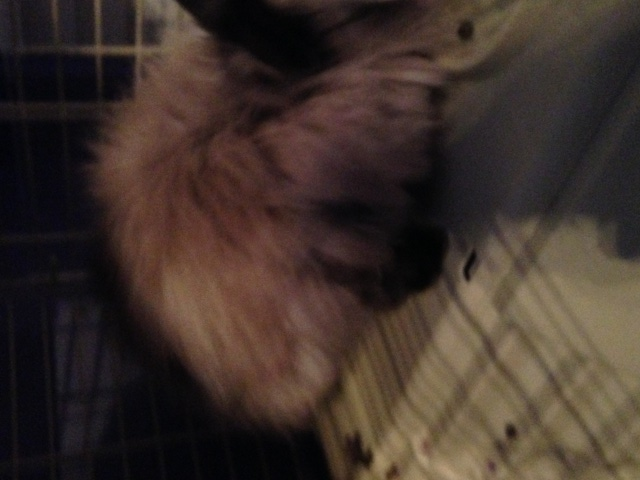 Lionhead rabbit breed colors
QuestionLionhead buck senior (
QUESTION: Believe
Lionhead rabbit breed colors
QuestionLionhead buck senior (
QUESTION: Believe
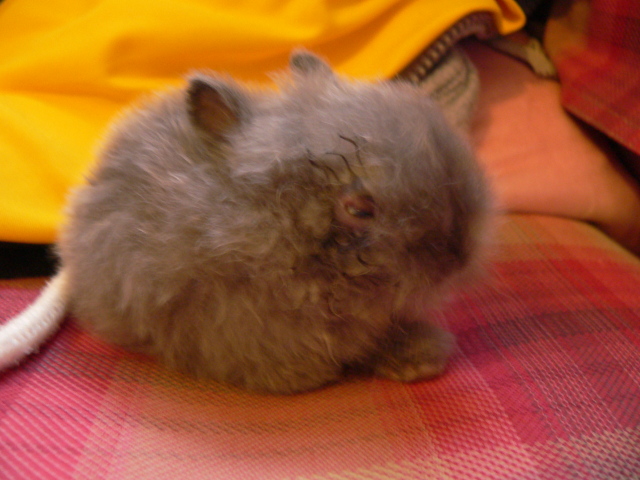 help please!
QuestionQUESTION: Your Question Edit Question
hi, my r
help please!
QuestionQUESTION: Your Question Edit Question
hi, my r
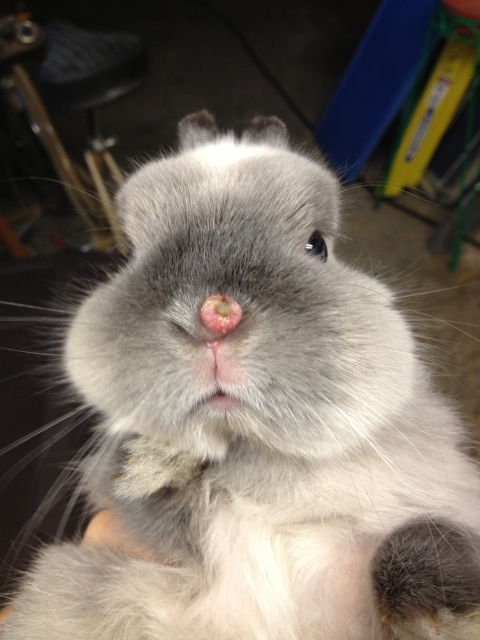 Bump on my rabbits nose
Question
bump on nose bump on nose 2
Breed
Bump on my rabbits nose
Question
bump on nose bump on nose 2
Breed
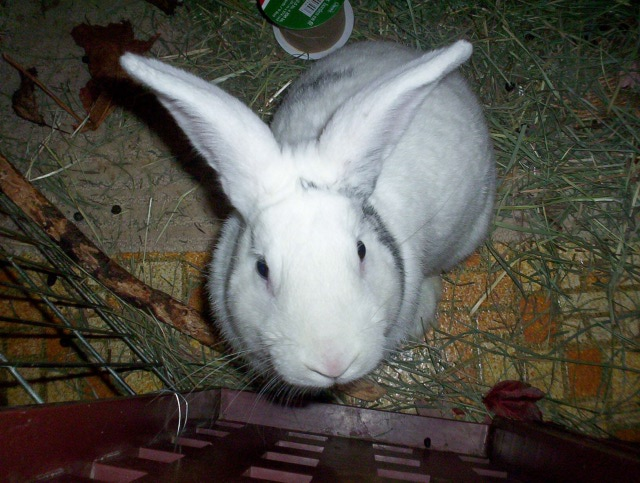 Rabbit urinating outside litter box
Question
Very large white male Very large white
Rabbit urinating outside litter box
Question
Very large white male Very large white
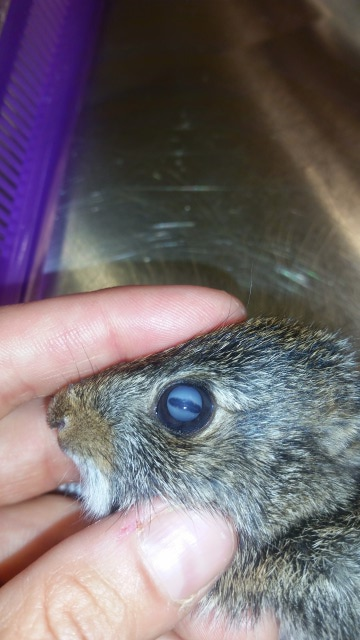 Eastern Cottontails
Question
ECT eye ECT eye
Hello Dr. Krempel
Eastern Cottontails
Question
ECT eye ECT eye
Hello Dr. Krempel